2.2RNN
RNN
RNN无法回忆起长久的记忆
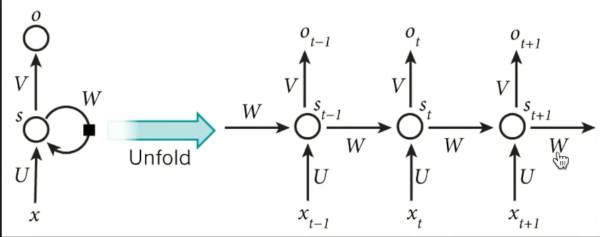
LSTM
(long short Term memory长短期记忆)解决梯度消失或弥散vanishing 和梯度爆炸explosion 0.9*n-->0 1.1*n--->无穷大
在RNN中增加了Gate
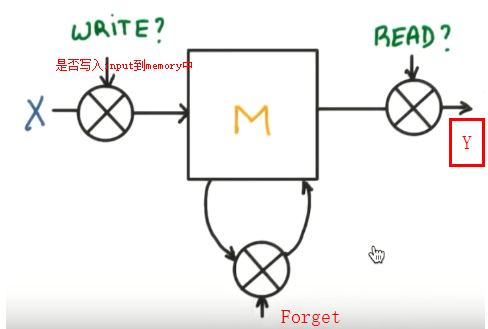
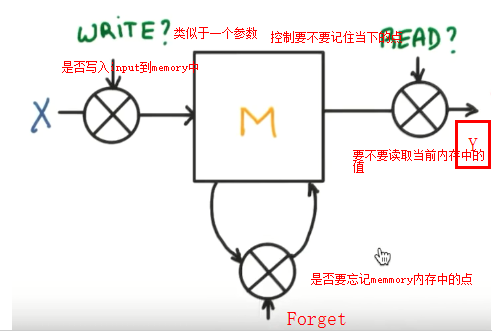
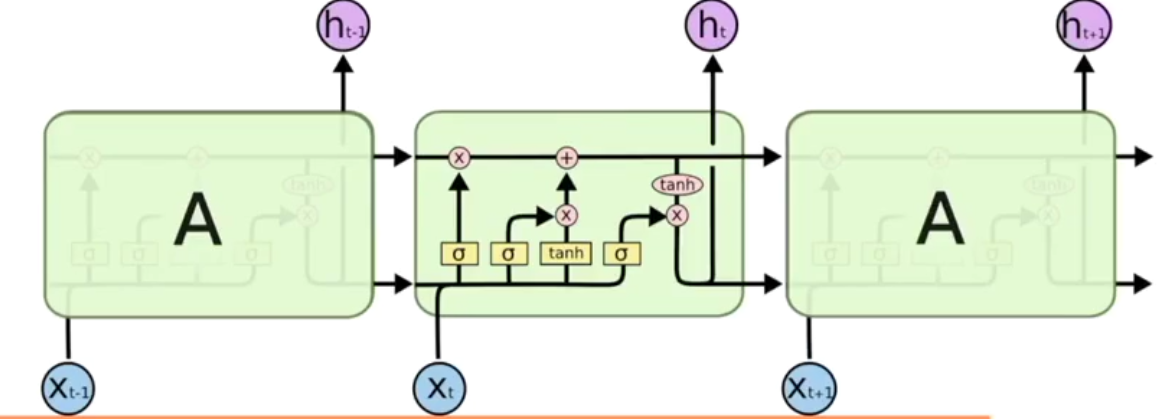
案例
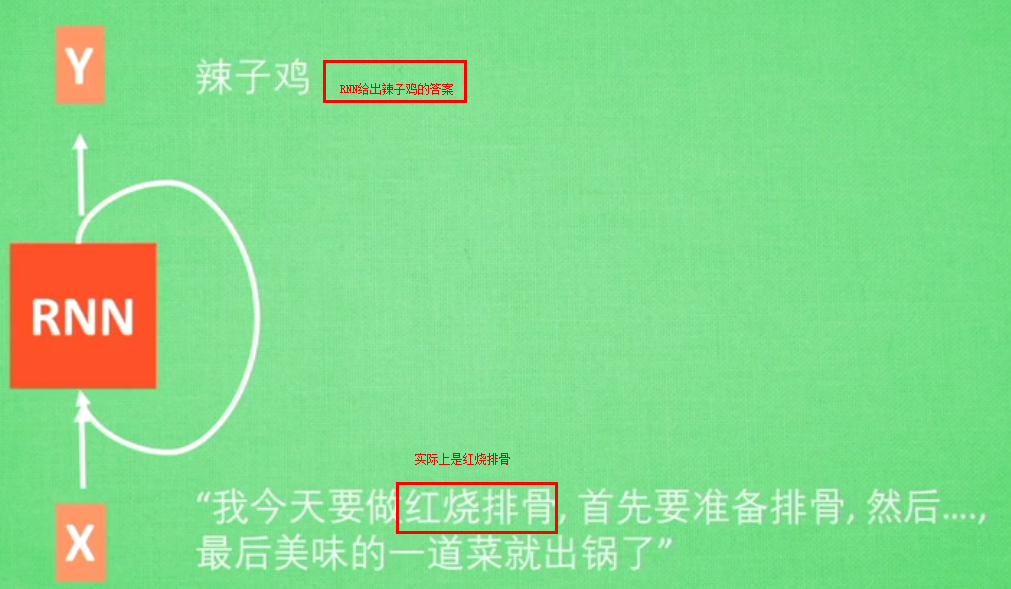
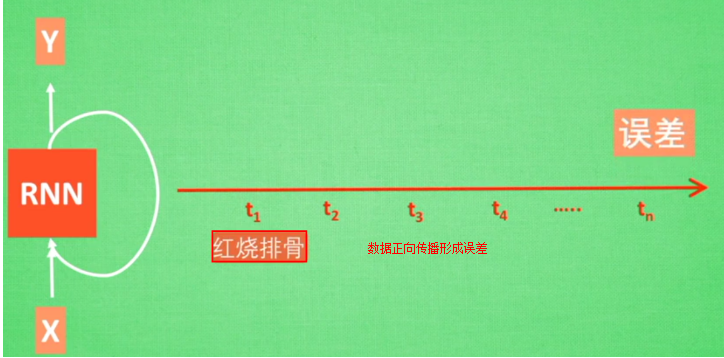
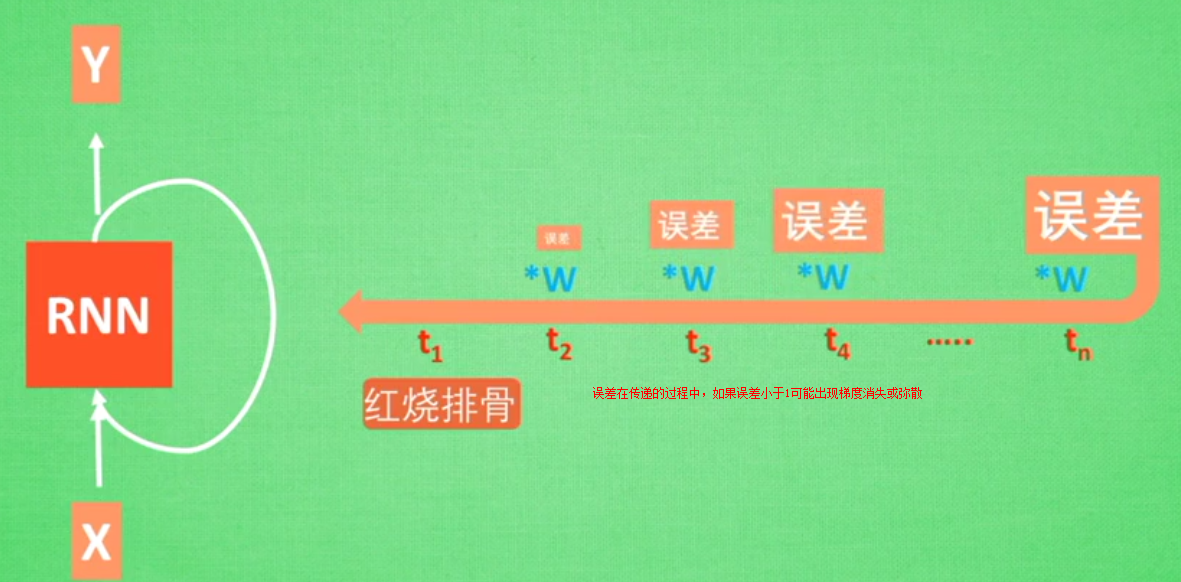
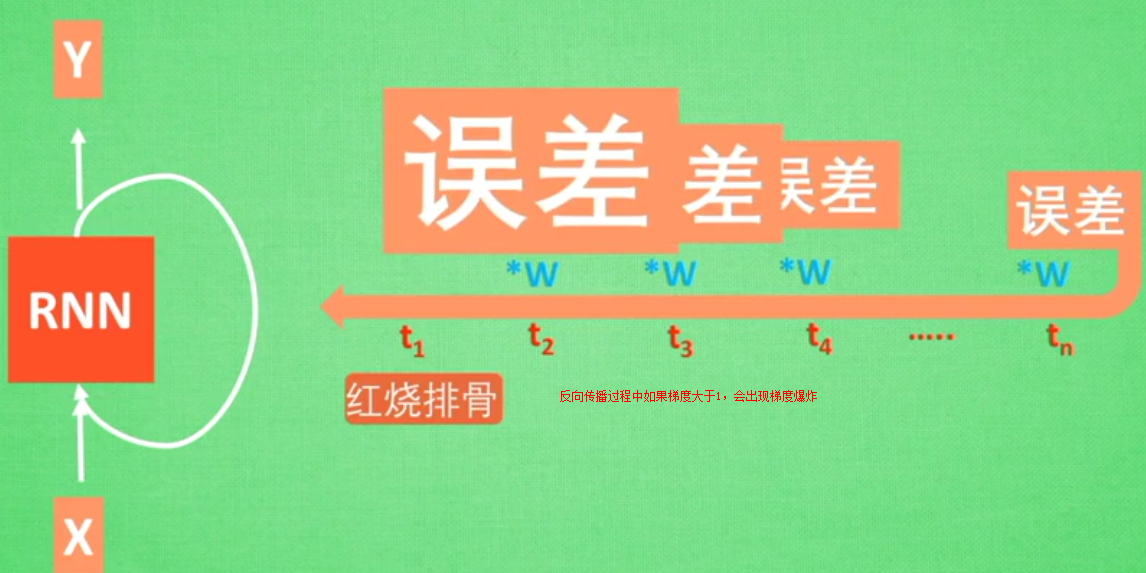
所以RNN无法回忆起长久的记忆。LSTM为了解决该问题多了三个控制器,做到了延缓记忆的功能
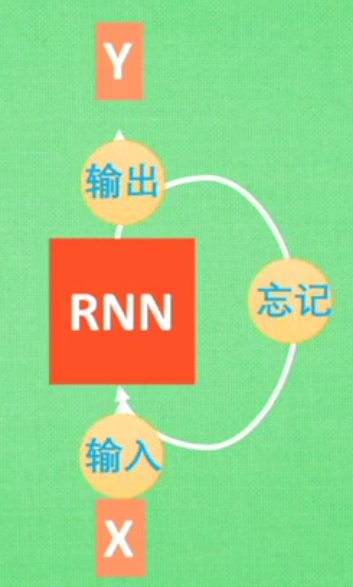
可以从主线和分线两个方面理解。LSTM可以解决延缓记忆问题
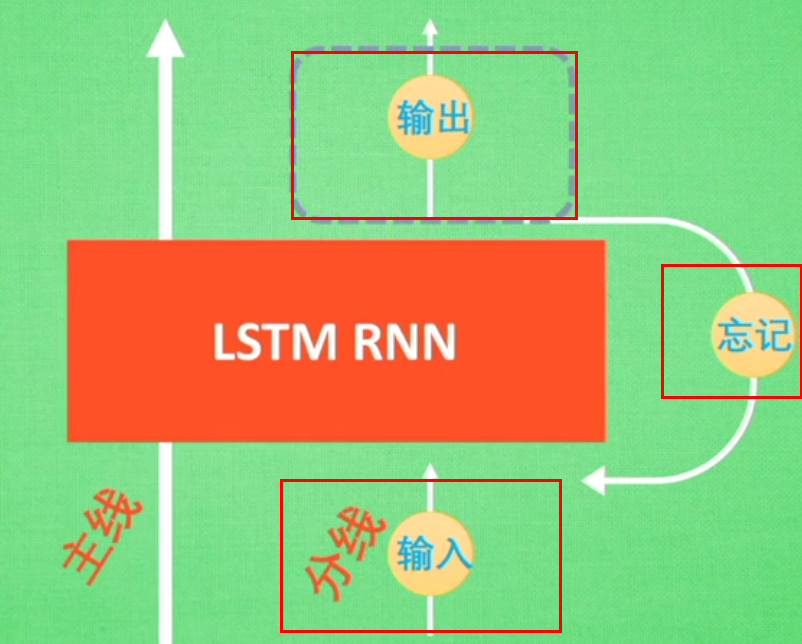
截断的反向传播BBPT
https://r2rt.com/styles-of-truncated-backpropagation.html
Tensorflow的截断反向传播(截断长度为n的子序列)的方法在定性上不同于“反向传播错误最多n步”。
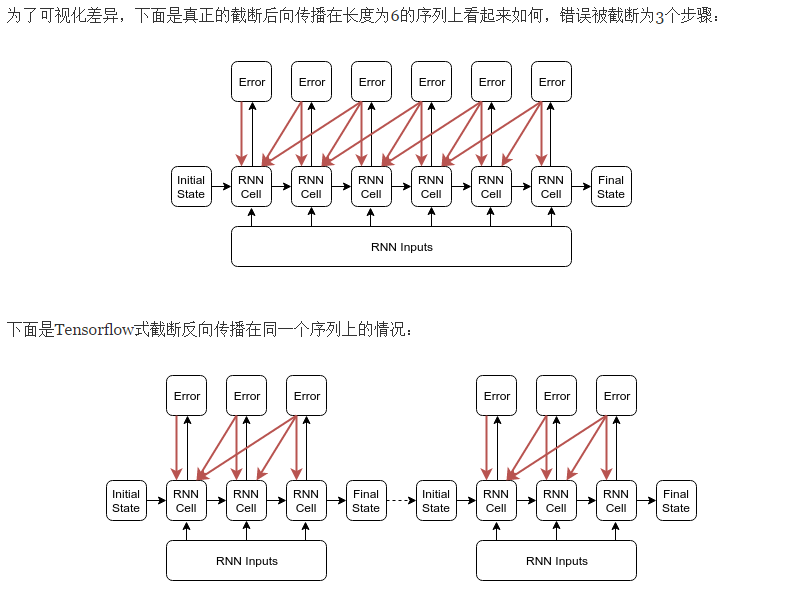
LSTM模拟sin图像解决回归问题代码
"""
Please note, this code is only for python 3+. If you are using python 2+, please modify the code accordingly.
Run this script on tensorflow r0.10. Errors appear when using lower versions.
"""
import tensorflow as tf
import numpy as np
import matplotlib.pyplot as plt BATCH_START = 0
TIME_STEPS = 20
BATCH_SIZE = 50
INPUT_SIZE = 1
OUTPUT_SIZE = 1
CELL_SIZE = 10
LR = 0.006 def get_batch():
global BATCH_START, TIME_STEPS
# xs shape (50batch, 20steps)
xs = np.arange(BATCH_START, BATCH_START+TIME_STEPS*BATCH_SIZE).reshape((BATCH_SIZE, TIME_STEPS)) / (10*np.pi)
seq = np.sin(xs)
res = np.cos(xs)
BATCH_START += TIME_STEPS
# plt.plot(xs[0, :], res[0, :], 'r', xs[0, :], seq[0, :], 'b--')
# plt.show()
# returned seq, res and xs: shape (batch, step, input)
return [seq[:, :, np.newaxis], res[:, :, np.newaxis], xs] class LSTMRNN(object):
def __init__(self, n_steps, input_size, output_size, cell_size, batch_size):
self.n_steps = n_steps
self.input_size = input_size
self.output_size = output_size
self.cell_size = cell_size
self.batch_size = batch_size
with tf.name_scope('inputs'):
self.xs = tf.placeholder(tf.float32, [None, n_steps, input_size], name='xs')
self.ys = tf.placeholder(tf.float32, [None, n_steps, output_size], name='ys')
with tf.variable_scope('in_hidden'):
self.add_input_layer()
with tf.variable_scope('LSTM_cell'):
self.add_cell()
with tf.variable_scope('out_hidden'):
self.add_output_layer()
with tf.name_scope('cost'):
self.compute_cost()
with tf.name_scope('train'):
self.train_op = tf.train.AdamOptimizer(LR).minimize(self.cost) def add_input_layer(self,):
l_in_x = tf.reshape(self.xs, [-1, self.input_size], name='2_2D') # (batch*n_step, in_size)
# Ws (in_size, cell_size)
Ws_in = self._weight_variable([self.input_size, self.cell_size])
# bs (cell_size, )
bs_in = self._bias_variable([self.cell_size,])
# l_in_y = (batch * n_steps, cell_size)
with tf.name_scope('Wx_plus_b'):
l_in_y = tf.matmul(l_in_x, Ws_in) + bs_in
# reshape l_in_y ==> (batch, n_steps, cell_size)
self.l_in_y = tf.reshape(l_in_y, [-1, self.n_steps, self.cell_size], name='2_3D') def add_cell(self):
lstm_cell = tf.contrib.rnn.BasicLSTMCell(self.cell_size, forget_bias=1.0, state_is_tuple=True)
with tf.name_scope('initial_state'):
self.cell_init_state = lstm_cell.zero_state(self.batch_size, dtype=tf.float32)
self.cell_outputs, self.cell_final_state = tf.nn.dynamic_rnn(
lstm_cell, self.l_in_y, initial_state=self.cell_init_state, time_major=False) def add_output_layer(self):
# shape = (batch * steps, cell_size)
l_out_x = tf.reshape(self.cell_outputs, [-1, self.cell_size], name='2_2D')
Ws_out = self._weight_variable([self.cell_size, self.output_size])
bs_out = self._bias_variable([self.output_size, ])
# shape = (batch * steps, output_size)
with tf.name_scope('Wx_plus_b'):
self.pred = tf.matmul(l_out_x, Ws_out) + bs_out def compute_cost(self):
losses = tf.contrib.legacy_seq2seq.sequence_loss_by_example(
[tf.reshape(self.pred, [-1], name='reshape_pred')],
[tf.reshape(self.ys, [-1], name='reshape_target')],
[tf.ones([self.batch_size * self.n_steps], dtype=tf.float32)],
average_across_timesteps=True,
softmax_loss_function=self.ms_error,
name='losses'
)
with tf.name_scope('average_cost'):
self.cost = tf.div(
tf.reduce_sum(losses, name='losses_sum'),
self.batch_size,
name='average_cost')
tf.summary.scalar('cost', self.cost) @staticmethod
def ms_error(labels, logits):
return tf.square(tf.subtract(labels, logits)) def _weight_variable(self, shape, name='weights'):
initializer = tf.random_normal_initializer(mean=0., stddev=1.,)
return tf.get_variable(shape=shape, initializer=initializer, name=name) def _bias_variable(self, shape, name='biases'):
initializer = tf.constant_initializer(0.1)
return tf.get_variable(name=name, shape=shape, initializer=initializer) if __name__ == '__main__':
model = LSTMRNN(TIME_STEPS, INPUT_SIZE, OUTPUT_SIZE, CELL_SIZE, BATCH_SIZE)
sess = tf.Session()
merged = tf.summary.merge_all()
writer = tf.summary.FileWriter("logs", sess.graph)
# tf.initialize_all_variables() no long valid from
# 2017-03-02 if using tensorflow >= 0.12
if int((tf.__version__).split('.')[1]) < 12 and int((tf.__version__).split('.')[0]) < 1:
init = tf.initialize_all_variables()
else:
init = tf.global_variables_initializer()
sess.run(init)
# relocate to the local dir and run this line to view it on Chrome (http://0.0.0.0:6006/):
# $ tensorboard --logdir='logs' plt.ion()
plt.show()
for i in range(200):
seq, res, xs = get_batch()
if i == 0:
feed_dict = {
model.xs: seq,
model.ys: res,
# create initial state
}
else:
feed_dict = {
model.xs: seq,
model.ys: res,
model.cell_init_state: state # use last state as the initial state for this run
} _, cost, state, pred = sess.run(
[model.train_op, model.cost, model.cell_final_state, model.pred],
feed_dict=feed_dict) # plotting 绘制训练sin图像的过程
plt.plot(xs[0, :], res[0].flatten(), 'r', xs[0, :], pred.flatten()[:TIME_STEPS], 'b--')
plt.ylim((-1.2, 1.2))
plt.draw()
plt.pause(0.3) #每隔3秒运行一次 if i % 20 == 0:
print('cost: ', round(cost, 4))
result = sess.run(merged, feed_dict)
writer.add_summary(result, i)
程序运行结果
下面的图像是拟合正弦曲线的过程
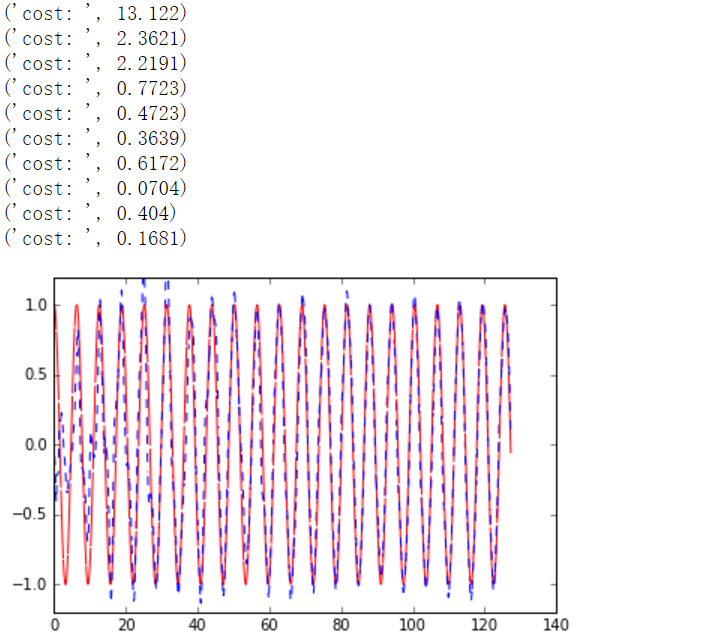
2.2RNN的更多相关文章
- PYTHON深度学习6.2RNN循环网络
#简单的循环网络 #-*-coding:utf-8 -*- from keras.datasets import imdbfrom keras.preprocessing import sequenc ...
- Auty自动化测试框架第五篇——框架内部的调用支持、自动化安装库与配置说明
[本文出自天外归云的博客园] 本次对Auty自动化测试框架做些收尾工作,由于在scripts文件夹中的脚本会需要调用其他包结构文件夹中的脚本,所以这里需要添加一下框架对于内部脚本间互相调用的支持,这里 ...
- python就业班-淘宝-目录.txt
卷 TOSHIBA EXT 的文件夹 PATH 列表卷序列号为 AE86-8E8DF:.│ python就业班-淘宝-目录.txt│ ├─01 网络编程│ ├─01-基本概念│ │ 01-网络通信概述 ...
- ssrf小记
SSRF(Server-Side Request Forgery, 服务端请求伪造),攻击者伪造服务端发起的请求并执行,从而获得一些数据或进行攻击 一.危害 1.对内网的端口和服务进行扫描,对主机本地 ...
随机推荐
- python装饰器、继承、元类、mixin,四种給类动态添加类属性和方法的方式(一)
介绍装饰器.继承.元类.mixin,四种給类动态添加类属性和方法的方式 有时候需要給类添加额外的东西,有些东西很频繁,每个类都需要,如果不想反复的复制粘贴到每个类,可以动态添加. # coding=u ...
- JAVA WEB ------ 文件下载及导出数据到office Execl表格
文件下载需要五步: 1.设置文件ContentType类型 // 设置文件ContentType类型,这样设置,会自动判断下载文件类型 response.setContentType("mu ...
- Java 代码块:静态代码块、构造代码块、构造函数块
Class : StaticFa package edu.bai.du.lime.staticCode; public class StaticFa { // 随着类的声明而执行 static { S ...
- 线程同步 – lock和Monitor
在多线程代码中,多个线程可能会访问一些公共的资源(变量.方法逻辑等等),这些公共资源称为临界区(共享区):临界区的资源是不安全,所以需要通过线程同步对多个访问临界区的线程进行控制. 同样,有些时候我们 ...
- 浅谈PostgreSQL的索引
1. 索引的特性 1.1 加快条件的检索的特性 当表数据量越来越大时查询速度会下降,在表的条件字段上使用索引,快速定位到可能满足条件的记录,不需要遍历所有记录. create table t(id i ...
- scala中to和util操作
// Range:to:默认步进为1 val to1 = 1 to 10 println(to1) // 定义一个不进为2的Range val to2 = 1 to 10 by 2 println(t ...
- C#中的垃圾回收机制与delegate
在DeepStream的C#版本调试过程中,发现了一个问题,运行一段时间后,大概每次内存到16M(Debug模式)就会异常 错误“System.NullReferenceException:未将对象引 ...
- Git服务器的搭建和使用
一.GIT服务器的搭建 1. 安装Git yum -y install git 2. 创建git用户 adduser git 3. 创建证书登陆 收集所有客户端需要登录的用户的公钥,就是他们自己的 ...
- 【整理】LINUX下使用CMAKE安装MYSQL
原文地址:http://www.cppblog.com/issay789/archive/2013/01/05/196967.html 一.安装 m4 下载地址: http://files.w3pc. ...
- Material Design系列第八篇——Creating Lists and Cards
Creating Lists and Cards //创建列表和卡片 To create complex lists and cards with material design styles in ...
